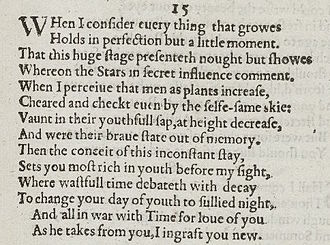Sonnet 15
Q1
Q2
Q3
C
When I consider every thing that grows
Holds in perfection but a little moment,
That this huge stage presenteth nought but shows
Whereon the stars in secret influence comment;
When I perceive that men as plants increase,
Cheer’d and check’d even by the self-same sky,
Vaunt in their youthful sap, at height decrease,
And wear their brave state out of memory;
Then the conceit of this inconstant stay
Sets you most rich in youth before my sight,
Where wasteful Time debateth with Decay,
To change your day of youth to sullied night;
And all in war with Time for love of you,
As he takes from you, I engraft you new.
4
8
12
14
Sonnet 15 is one of 154 sonnets written by the English playwright and poet William Shakespeare. It forms a diptych with Sonnet 16, as Sonnet 16 starts with "But...", and is thus fully part of the procreation sonnets, even though it does not contain an encouragement to procreate. The sonnet is within the Fair Youth sequence.
Also known as "When I consider every thing that grows," Sonnet 15 is one of English playwright and poet William Shakespeare's acclaimed 154 sonnets. It is a contained within the Fair Youth sequence, considered traditionally to be from sonnet 1-126 "which recount[s] the speaker's idealized, sometimes painful love for a femininely beautiful, well-born male youth". In another subcategory the sonnet is also contained within what is known as the Procreation sonnets.
According to Vendler, the sonnet is the first to employ Shakespeare's grand microcosmic scale, more suited to philosophy than a sonnet about love. Shakespeare begins the poem by with the speaker "look[ing] on life from the vantage point of the stars above in his consideration; yet he sees as well from a helpless human perspective below." The poem then introduces a "retrospective reading of ingraft" that denotes immortalizing the Fair Youth that continues in Sonnet 16.
Sonnet 15 is part of the Fair Youth sequence, or sonnets 1–126, as established by the 1609 Quarto, which was "divided into two parts, the first concerning a beautiful male youth and the second a woman." This sequence emphasizes "longing, jealousy, and a fear of separation, while anticipating both the desire and the anguish of the subsequent poems."
...
Wikipedia

